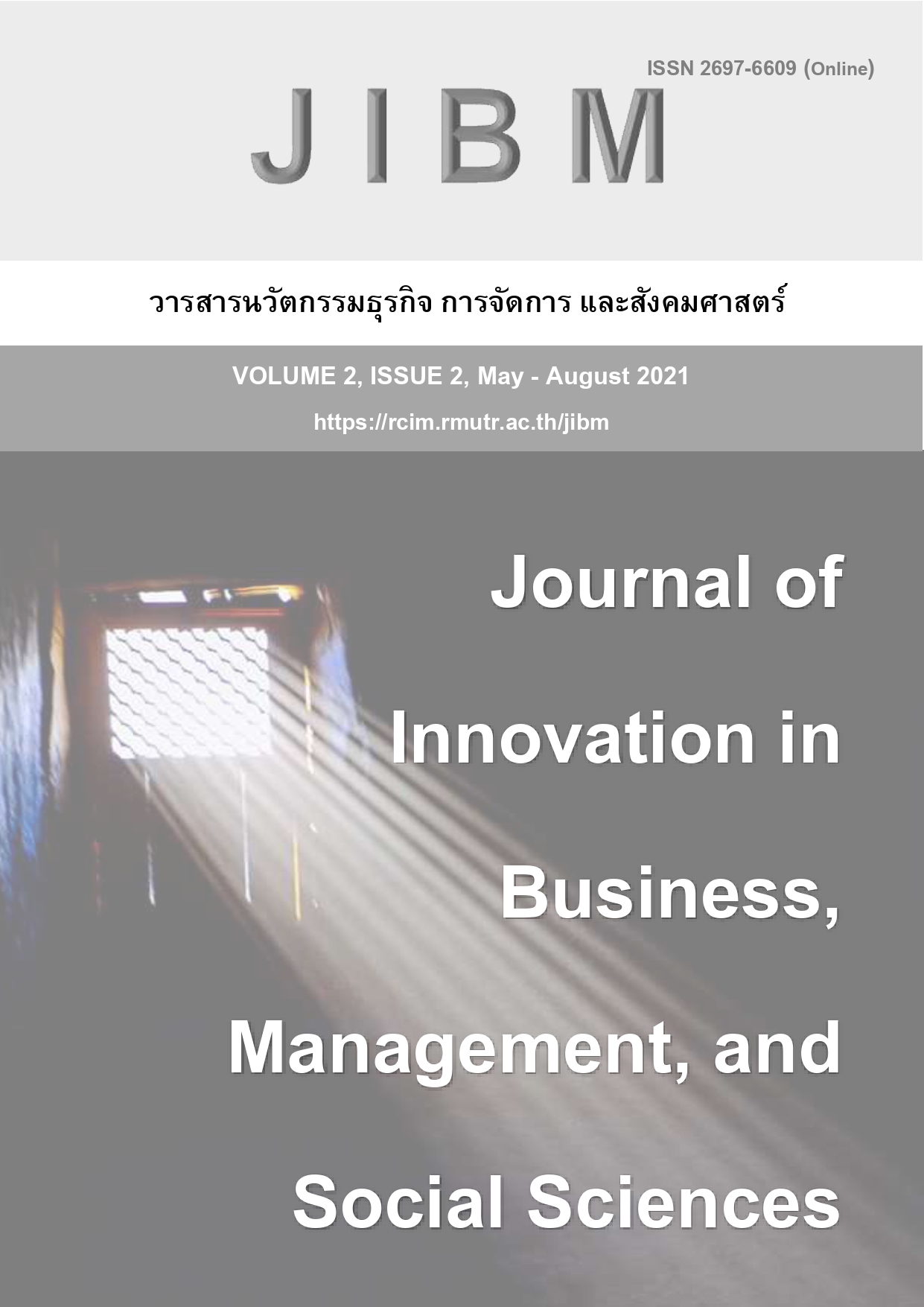อิทธิพลของการบริหารลูกค้าสัมพันธ์ (CRM) ที่ส่งผลต่อ ผลการปฏิบัติงานขององค์กร กรณีศึกษา ธนาคารพาณิชย์ในประเทศไทย
คำสำคัญ:
การบริหารลูกค้าสัมพันธ์, ผลการปฏิบัติงานขององค์กรด้านการเงิน, ผลการปฏิบัติงานขององค์กรด้านลูกค้า, ผลการปฏิบัติงานขององค์กรด้านกระบวนการภายใน, ผลการปฏิบัติงานขององค์กรด้านการเรียนรู้และพัฒนาบทคัดย่อ
การวิจัยในครั้งนี้ได้มีการศึกษาปัจจัยด้านการบริหารลูกค้าสัมพันธ์ (CRM) ที่ส่งผลต่อ ผลการปฏิบัติงานขององค์กร ได้แก่ ผลการปฏิบัติงานขององค์กรด้านการเงิน, ผลการปฏิบัติงานขององค์กรด้านลูกค้า, ผลการปฏิบัติงานขององค์กรด้านกระบวนการภายใน และ ผลการปฏิบัติงานขององค์กรด้านการเรียนรู้และพัฒนา เป็นกรณีศึกษา ธนาคารพาณิชย์ในประเทศไทย ด้วยการเก็บข้อมูลจากแบบสอบถามออนไลน์ เพื่อวัดความคิดเห็นจากกลุ่มตัวอย่าง 300 ตัวอย่าง ซึ่งกลุ่มตัวอย่างคือ พนักงานภายในองค์กรกลุ่มธุรกิจธนาคาร ที่เกี่ยวข้องกับการบริหารลูกค้าสัมพันธ์ และวิเคราะห์ผลด้วยเทคนิคการวิเคราะห์ถดถอยเชิงพหุคูณ ผลการวิจัยพบว่า ผลการปฏิบัติงานขององค์กร ทั้ง 4 ปัจจัย มีค่า Sig. น้อยกว่า 0.05 นอกจากนี้การทดสอบสมมติฐาน ยังแสดงให้เห็นว่าปัจจัยการบริหารลูกค้าสัมพันธ์ การบริหารลูกค้าสัมพันธ์นั้นส่งผลเชิงบวกต่อ ผลการปฏิบัติงานขององค์กรในด้านการเงิน, ด้านลูกค้า และด้านการเรียนรู้และพัฒนา แต่ส่งผลเชิงลบต่อ ผลการปฏิบัติงานขององค์กรในด้านกระบวนการภายใน ซี่งงานวิจัยนี้มีประโยชน์สำหรับธนาคารในการให้บริการลูกค้าให้เกิดความพึงพอใจและประทับใจสูงสุด
เอกสารอ้างอิง
Abdullateef, A.O., Mokhtar, S.S., & Yusoff, R.Z. (2010). The impact of CRM dimensions on call center performance. International Journal of Computer Science and Network Security, 10 (12), 184-195.
Anonymous. (2006). Non-Financial data can predict future profitability. Business Credit, 108 (4), 57.
Ashton, C. (1998). Balanced scorecard benefits Nat West Bank. International Journal of Retail and Distribution Management, 26 (10), 400-407.
Asikhia, O. (2010). Customer orientation and firm performance among Nigerian small andmedium scale businesses. International Journal of Marketing Studies, 2 (1), 197-213.
Croteau, A. M., & Li, P. (2003). Critical success factors of CRM technological initiatives. Canadian Journal of Administrative Sciences, 20 (1), 21-34.
Davis, S., & Albright, T. (2004). An investigation of the effect of the balanced scorecard implementation on financial Performance. Management Accounting Research, 15 (2), 135-153.
Dowling, J. (1993). Organizational legitimacy: social values and organizational behavior. Pacific Sociological Review, 18 (10), 122-136.
Kaplan, R.S., & Norton, D.P. (1992). The balanced scorecard: measures that drive performance. Harvard Business Review, 1 (2), 71-79.
Kim, C.S., & Davidson, L.F. (2004). The effects of IT expenditures on bank' business Performance: Using a balance scorecard approach. Managerial finance, 30 (6), 28-45.
Kotler, P., & Armstrong, G. (2013). Marketing: An Introduction (3rd ed.). USA: Prentice Hall.
Leung, L.C., Lam, K.C.K., & Cao, D. (2006). Implementing the balanced scorecard using the analytic hierarchy process and the analytic network process. Journal of the Operational Research Society, 57 (6), 682-691.
Liu, S.S., Luo, X., & Shi, Y. (2003). Market oriented organizations in an emerging economy: a study of the missing links. Journal of Business Research, 56 (6), 481-491.
Mouritsen, L., Thorsgaard, L.H., & Bukh, P.N. (2005). Dealing with the knowledge economy: Intellectual capital versus balance scorecard. Journal of Intellectual Capital, 6 (1), 8-27.
Payne, A., & Frow, P. (2005). A Strategic Framework for Customer Relationship Management. Journal of Marketing, 69 (11), 167-176.
Randolph, W.A., & Dess, G.G. (1984). The congruence of perspective of organizational design: a conceptual model and multivariate research approach. Academy of Marketing Review, 9 (1), 114-127.
Shi, J., & Yip, L. (2007). Driving innovation and improving employee capability: the effects of customer knowledge sharing on CRM. The Business Review, 7 (1), 107-112.
Sin, L.Y.M., Tse, A.C.B., & Yim, F.H.K. (2005). CRM: conceptualization and scale development. European Journal of Marketing, 39 (11), 1264-1290.
Tajeddini, K. (2010). Effect of customer orientation and entrepreneurial orientation on innovativeness: evidence from the hotel industry in Switzerland. Tourism Management, 31 (2), 221-231.
Wu, S.I., & Hung, J.M. (2007). The Performance measurement of cause-related marketing by balance scorecard. Total Quality Management, 18 (7), 771-791.
Wu, S.I., & Lu, C. (2012). The relationship between CRM, RM, and business Performance: A study of the hotel industry in Taiwan. International Journal of Hospitality Management, 31 (1), 276-285.
Yueh, C.L., Lee, Y., & Barnes, F.B, (2010). The effects of leadership styles on knowledge-based customer relationship management implementation. International Journal of Management and Marketing Research, 3 (1), 1-19.



